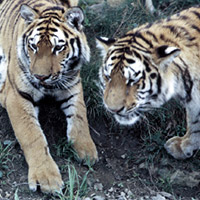Mammals - Siberian Tiger
 Region:
Eurasia Region:
Eurasia
Class: Mammalia
Order: Carnivora
Family: Felidae
Genus: Panthera
Scientific Name: Panthera tigris altaica
Description: This species is the largest of all cats.
It is a massively built animal with a rounded head, muscular
body, powerful limbs, especially the forearm and shoulder
which enables it to overpower a prey larger than itself.
The tail is usually slightly shorter than half the head
and body length. Ears small and rounded. Old males have
massive forequarters and huge heads. The muzzle is relatively
broader than in other tiger species. Large canine teeth.
Length of head and body: 1.8 - 2.8 m Length of tail: 0.9
m Weight: 180 - 306 kg males; 100 - 167 kg females
Distribution: Southeastern Siberia and Manchuria.
Habitat: Reeds and bushes in river valleys, mountain taiga
and mixed forests traversed by rivers with rock outcroppings.
In summer they live at altitudes of up to 1200 m; in winter
they move to lower altitudes.
Food: The Siberian tiger's diet consists of deer, wild
pig and occasionally fish. If its chief prey is lacking,
it feeds on carrion and catches birds, small mammals,
turtles and insects. In summer they also eat grass, cedar
nuts, fruits and berries.
Skin/Color/Coat: The summer coat is fairly short and smooth
and a tawny gold in colour. The winter coat is very full
and long and a more pale yellowish colour. The stripes
are brown in colour and less numerous.
Vocalization: It is thought that tigers roar to announce
a kill and to attract the opposite sex. Vocal calls of
tigers include startled ‘woofs”, roars during
mating, rasping grunts by tigress to call young, purring
and soft grunts of puffing sounds. The tiger also communicates
by marking with urine, feces and scratches.
Reproduction and Development: There is no particular mating
season. They reproduce once in 2 or 3 years. Tigers are
solitary and only come together to mate. They may remain
together for 5 or 6 days after which the male moves off.
After a gestation period of three to three and a half
months, she delivers a litter of two to four kittens,
in a well protected den, which may be a natural cave,
a rocky crevice or dense vegetation (pits left by overturned
trees). The kittens are born blind and will open their
eyes at about two weeks. Newborns weigh 780 - 1600 g.
The female tiger feeds the cubs until they reach five
to six months of age. At this time they are able to go
with her on hunting trips. At one year of age, the cubs
are able to hunt for themselves. The cubs continue to
stay with their mother until they are three to five years
old. They will leave to find their own territories and
mates. Sexual maturity is attained in the fourth year.
Only about 50% of the cubs survive beyond 2 years. Lifespan
is 26 years both in the wild and in captivity.
Adaptations: Tigers are mostly nocturnal, but in the northern
regions they are also active during the day. They are
cryptically coloured for the habitat. The black lines
serve to break up their body shape in tall grasslands.
They are seldom found far from rivers or other water sources.
They swim well and enjoy launching in the water on hot
days. Tigers are well equipped for hunting. They are extremely
flexible. This flexibility is caused by the fact that
the bones are attached to the muscles and tendons without
strong ligaments. Their keen eyesight picks up even the
slightest movement. The tiger's large, cup- shaped ears
focus sounds, making its hearing very sensitive. A tiger's
long, stiff whiskers are used as feelers to help it maneuver
through twigs and branches in the dark. The tiger's sense
of smell is also excellent. Siberian tigers have long
sharp retractable claws for catching and holding prey.
The claws are pulled into a protective sheath to prevent
them from becoming worn down while walking on rocks or
hard ground, keeping them very sharp. Characterized by
extreme strength, agility and endurance, they move noiselessly
making daily marches of up to 80 km. The tiger stalks
its prey, steals up from behind or from the side, then
attacks in several large leaps of 5 - 7 m and 2 m high,
trying to simultaneously throw it down and grab its throat.
Killing is by strangulation or a bite to the back of the
neck. The carcass is often dragged to an area within cover
or near water to hide it from other predators. The Siberian
tiger needs to eat at least 9-10 kg (20 lbs.) of meat
a day to survive the cold climate of its environment.
The tiger can eat up to 45 kg (100 lbs.) of meat at one
meal. Only one hunt out of 10 is successful. When food
is available and the tiger remains unmolested, it stays
in its selected region. It marks and patrols its territory
and avoids fights. Normal range is 500 - 400 square km,
established for life.
Threats: Pressures from illegal killing, or poaching,
and habitat loss. Tiger body parts are in high demand
in all of Asia for fur and medicines, putting the Siberian
tiger in serious danger of extinction.
Status: Endangered
References: Cavendish, Marshal, Endangered Wildlife of
the World, Volume 9, N.Y., 1993 Grzimek, Bernhard: 1975
Animal Life Encyclopedia, Vol XII, Van Nostrand Reinhold
Co., N.Y. Guggisberg, C.A.W.;Wild Cats of the World, David
& Charles (Holding), 1975 Hornocker, Maurice; National
Geographic, February, 1997 Novikow, G.A., 1962 Carnivorous
Mammals of the Fauna of the USSR, Israel Programme for
Scientific Translations, Jerusalem Nowak, Ronald, M.,
Walker’s Mammals of the World, Fifth Edition, Vol.
2, 1991. |
|
|
